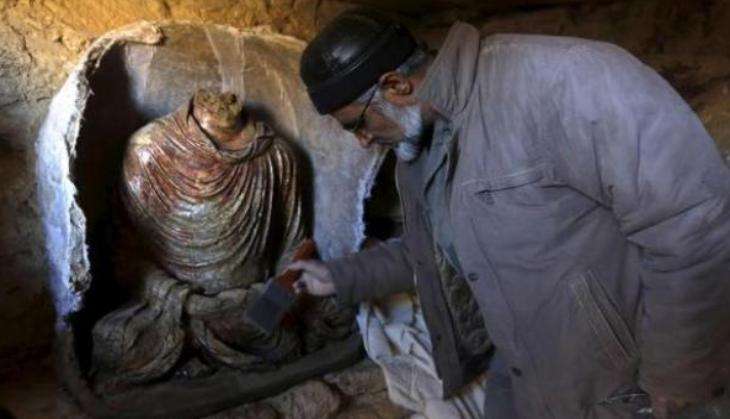Buddhism
Related: About this forumChina to destroy ancient Buddhist city of 'Mes Aynak' in Afghanistan for copper mining

NEWS AGENCIES | First published: 3 February 2017, 14:35 IST
A new documentary has revealed that two Chinese state-owned mining companies have plans to destroy an ancient Buddhist city of 'Mes Aynak' in Afghanistan for copper mining.
According to the film 'Saving Mes Aynak', Metallurgical Group Corporation (MCC) and Jiangxi Copper are in the initial stages of building an open-pit copper mine, 40km southeast of Kabul. The location is home to a walled Buddhist city that dates back 5,000 years, reports the South China Morning Post.
According to the Afghan Ministry of Mines and Petroleum, the site is also home to the world's second-largest copper deposit. China is an importer of copper and a major global refiner of the industrial metal.
http://www.catchnews.com/world-news/china-to-destroy-ancient-buddhist-city-of-mes-aynak-in-afghanistan-for-copper-mining-1486112644.html
http://www.savingmesaynak.com/
liberal N proud
(61,104 posts)The same will happen in America, antiquities and natural treasures will no longer be protected.
packman
(16,296 posts)Not as long as there is cheaper labor, less restrictions, third-world countries and their governments and people to exploit. Here we elect the asswipes who protect the industries doing this in other countries so they can bribe and corrupt them with impunity. Americans are getting increasingly sensitive to environmental abuse and it is becoming too political to have open-pit copper mines like we once (and I think still do) had or destroy ancient early American sites to run an oil pipe line through.
grantcart
(53,061 posts)1) Guatama was born 2580, there are no Buddhist cities that date back 5,000 years. The Buddhists built their city over the archaeological remains of the Bronze age cities underneath it.
2) If it wasn't sitting over the 2nd largest Copper reserve in the world then no archaeological work would be done there at all. In preparation for the mine hundreds of artefacts have been moved to the national museum, much larger than previously existed.
3) It is not a religious site in any way, but an important archaeological one. The copper reserves there are among the largest in the world and we need copper, lots of it to transform our energy grid away from carbon fuels. It makes good sense to have control over a few big sites than to have anarchy in hundreds of small ones.
4) Afghanistan is not, despite many articles to the contrary, a resource rich country. Its natural gas reserves which have been the focus of many claims that it is the reason for the Afghan war is not a resource that can be exported because a pipeline to a port is not realistic, it can only serve local needs.
The mine can generate tens of billions of revenue for the people of Afghanistan.
5) Given the above, I think it is highly unrealistic to think that there is any chance that this mine will not go forward, ironically the only reason that there are human sites there is because it is such a rich mining area.
The focus should be to
a) move all moveable relics
b) ensure the benefit for all Afghan people
c) use a share of the revenue to advance archaeological digs in the mine and through out Afghanistan.
The reality is that a great deal of archaeological sites are in remote areas that would never ben found or developed without some other financial incentive. The discovery and study of dinosaur fossil remains in North America was only made possible by allowing a degree of profit motive for those involved.
The wiki page seemed to give a more balanced view:
In June 2012, a conference of experts in the fields of geology, mining engineering, archaeology, history and economic development met at SAIS in Washington, D.C to assess the situation in Mes Aynak. The provisional findings were tentatively encouraging: because of the length of time before mining can actually start at the site (approximately five years), it is indeed possible for collaboration between archaeologists and mining engineers to work to save Mes Aynak's cultural treasures. The site could either become a positive model for mineral extraction working to preserve cultural heritage or become an irreparable failure. However, a number of measures, that are not currently in place, must be met first. The site is still scheduled for destruction in January 2013.[15][16]
Excavators at Mes Aynak have been denounced as "promoting Buddhism" and threatened by the Taliban and many of the Afghan excavators who are working for purely financial reasons don't feel any connection to the Buddhist artifacts.[17]
Recent developments[edit]
The U.S. Embassy in Kabul has provided a million dollars of U.S. military funding to help save the Buddhist ruins.[18] As of June 2013 there is an international team of 67 archaeologists on site, including French, English, Afghans and Tajiks. There are also approximately 550 local labourers, which is set to increase to 650 in the summer. When this occurs Mes Aynak will become "the largest rescue dig anywhere in the world".[3] All these personnel are protected by 200 armed guards. The team are using ground-penetrating radar, georectified photography and aerial 3D images to produce a comprehensive digital map of the ruins.[3]